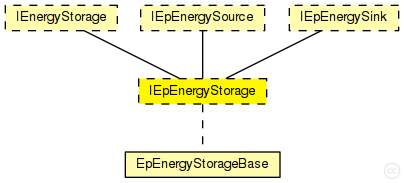 This documentation is released under the Creative Commons license
This documentation is released under the Creative Commons licenseThis interface extends the corresponding energy model interface. It requires implementations to describe energy consumption and energy generation with power [W] and storage capacity with energy [J]. The Ep is an abbreviation that is used for energy and power based interfaces.
See also: IEpEnergyConsumer, IEpEnergySource, IEpEnergyGenerator, IEpEnergySink, IEpEnergyManagement
Author: Levente Meszaros

The following diagram shows usage relationships between types. Unresolved types are missing from the diagram.

The following diagram shows inheritance relationships for this type. Unresolved types are missing from the diagram.

| Name | Type | Description |
|---|---|---|
| IEnergyStorage | module interface |
The energy storage models describe devices that absorb energy produced by generators, and provide energy for consumers. For example, an electrochemical battery in a mobile phone provides energy for its display, its CPU, and its wireless communication device. It can also absorb energy produced by a solar panel installed on its display, or by a portable charger plugged into a wall socket. |
| IEpEnergySource | module interface |
This interface extends the corresponding energy model interface. It requires implementations to describe energy consumption and energy generation with power [W] and storage capacity with energy [J]. The Ep is an abbreviation that is used for energy and power based interfaces. |
| IEpEnergySink | module interface |
This interface extends the corresponding energy model interface. It requires implementations to describe energy consumption and energy generation with power [W] and storage capacity with energy [J]. The Ep is an abbreviation that is used for energy and power based interfaces. |
| Name | Value | Description |
|---|---|---|
| display | i=block/plug |
| Name | Type | Unit |
|---|---|---|
| powerGenerationChanged | double |
// // This interface extends the corresponding energy model interface. It requires // implementations to describe energy consumption and energy generation with // power [W] and storage capacity with energy [J]. The Ep is an abbreviation // that is used for energy and power based interfaces. // // @see ~IEpEnergyConsumer, ~IEpEnergySource, ~IEpEnergyGenerator, ~IEpEnergySink, ~IEpEnergyManagement // @author Levente Meszaros // moduleinterface IEpEnergyStorage extends IEpEnergySource, IEpEnergySink, IEnergyStorage { parameters: @display("i=block/plug"); @signal[residualEnergyCapacityChanged](type=double); }